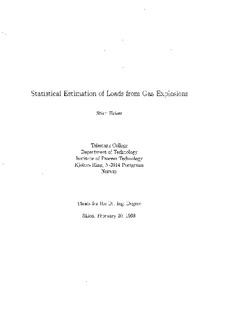| dc.description.abstract | In the design of structures in the offshore and process industries, the possibility of a gas explosion must always be considered. This is usually incorporated by performing explosion simulations. However, estimations based on such calculations introduce uncertainties in the design process. The main uncertainties in explosion simulations are the assumption of the gas cloud,the location of the ignition point and the properties of the explosion simulator itself. In this thesis, we try to investigate the level of these uncertainties and quantify them. This is done by performing a large number of simulations on three offshore modules; the Piper Alpha C module and the CMR M24 and M25 modules in full scale, and one onshoreplant; the Nypro UK plant at Flixborough.The simulations of the offshore modules show that there is an approximate linear relation between pressure and gas volume, it seems possible to find a linear relation between pressure and impulse, an inverse relation between pressure and duration is observed, the response of offshore structures exposed to gas explosion are rarely in the impul-sive regime, loading rates vary widely in magnitude, an assumption of a triangular explosion pulse is often correct, louvres increase pressure, impulse and duration of an explosion. The effect of ignition point location is studied in detail. The location of the ignition point may result in explosion pressure variation with a factor of 20. While explosion impulse as function of ignition point location seems to follow a normal distribution, explosion pressure has to be treated with non-parametric statistics. It is possible to derive an ignition point uncertainty load factor that shows predictable behaviour by generalising the non-parametric properties of the explosion pressure. The load factor will vary with the chosen level of safety. Values of this factor for the offshore modules with different gas volumes, gas types and different levels of safety are provided. Based on the mean of a few simulations, a factor of 2 will in general be sufficient to achieve the 90% quantile in any explosion distribution investigated. A model for taking into account the uncertainties regarding gas volume, ignition point location and simulator imperfectness is proposed. Several levels of safety may be chosen.The model is intended to produce a characteristic load for structural design. | |
